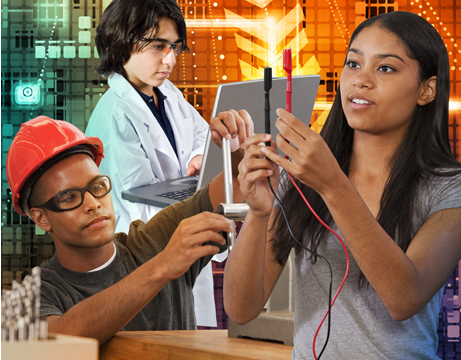STEM Programs Create Engineers of the Future
STEM Programs Create Engineers of the Future


Finding top talent has always been a challenge in the engineering field, especially now at a time when many in the media say high school students seem to be showing less interest in science, technology, engineering, and mathematics (STEM).
To meet the professional needs of STEM-related, high-growth industries, federal and state governments, as well as the private sector, are becoming more active in supporting STEM training programs for K-12 students. For example, Utah is funding a $10-million STEM Action Center, “which will be a hub of collaboration for communities, industries, higher education, and public education,” says Carol George, Utah’s state science advisor. “The goal is to produce a college-educated STEM workforce that can meet the needs of our growing high-tech industries.”
In the private sector, General Motors is working with the state of Michigan to support STEM programs. GM has agreed to help fund “Project Lead the Way,” a leading nonprofit provider of STEM curriculum for middle and high schools. These courses make engineering relevant by applying STEM principles in real-world contexts, which help students develop critical thinking skills.
“To ensure ourleadership in the automotive industry, we need to always look for opportunities to strengthen our involvement with science and math education programs,” says John Calabrese, GM vice president of globalvehicle engineering. “It is essential that the next generation of professionals has the skills and education necessary to compete on a global platform, particularly as it pertains to STEM-related fields.”
Private-Sector Leadership
David E. Cole is chairman emeritus of the Center for Automotive Research in Ann Arbor and former engineering professor at the University of Michigan. One of his passions is working with Building America’s Tomorrow, a new nonprofit whose mission is to develop K-12 STEM talent for the manufacturing industry.
“Kids don’t have manufacturing on their radar screen,” he says. “We have failed to get the message to young people about where the opportunities are in manufacturing. Part of our focus will be on video presentations that show what making things is all about. The Society of Automotive Engineers’ A World of Motion curriculum, for instance, is fantastic. We want to see these things presented in the classroom.”
In Colorado, CH2M Hill is working with Denver schools to support SEEK—the Summer Engineering Experience for Kids. The program was originally started by the National Society of Black Engineers in 2007 to bring more African Americans into STEM fields. According to the Economics and Statistics Administration, African-Americans and Hispanics each accounted for about 6 percent of Americans employed in STEM fields in 2011.
“All of us see the shortfall and we feel the responsibility and the need to bridge this gap,” says Karen Nakandakare, diversity program manager at CH2M Hill, the primary sponsor of the SEEK program in Denver.
Universities and K-12
Academic institutions are also ramping up STEM programs across the country.
“We really need a society that has a better understanding of the grand challenges facing us and how engineering and science will be needed to find solutions,” says Philip R. O'Leary, engineering professor at the University of Wisconsin-Madison. “I want students with STEM knowledge to advance into positions of leadership where they can use their scientific background and problem-solving skills to address the challenges associated with water, food, energy, health, and beyond.”
To help with this goal, UW-Madison’s College of Engineering launched Camp Badger Exploring Engineering in 1998. The program helps younger students understand engineering through hands-on experiences like field trips to a multi-story construction site, sports stadium, fusion reactor, biomedical engineering research lab, bicycle manufacturing plant, and electric power plant. About 2,600 students have participated in Camp Badger since its inception.
“We have built connections to labs on the UW-Madison campus, Madison-area companies, and local governmental agencies that provide fantastic hands-on experiences, tours, and demonstrations,” says O’Leary. “Engineers can discuss with the students how they do their work and what it means to be an engineer.”
Making a Difference
Engineering firms can provide opportunities for students to talk with engineers. “One of our favorite Camp Badger activities is a bus trip to a local industrial design firm where the students learn about making cool new products,” says O’Leary. “Every town that has both a school and a population of engineers will have plenty of things to see and do that will help students better understand STEM and its impact on the world.”
Professional engineers can also help out with school engineering clubs or provide financial support for the STEM enrichment that many schools struggle to pay for. “At the policy level, schools need participation by engineering leaders,” adds O’Leary. “Not many school boards have engineers as members.”
Mark Crawford is an independent writer.
We really need a society that has a better understanding of the grand challenges facing us and how engineering and science will be needed to find solutions.Prof. Philip R. O'Leary, University of Wisconsin-Madison


.png?width=854&height=480&ext=.png)



